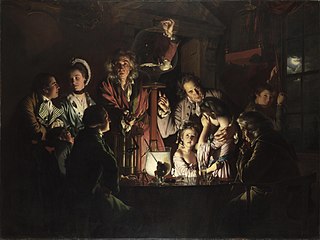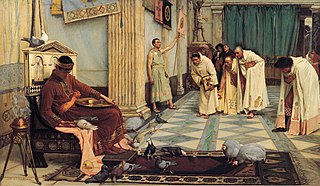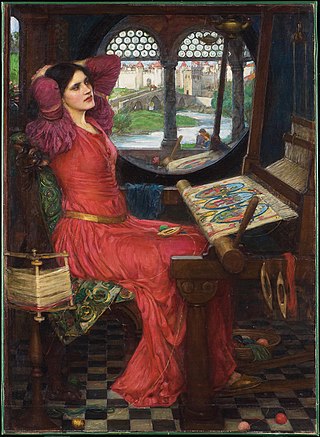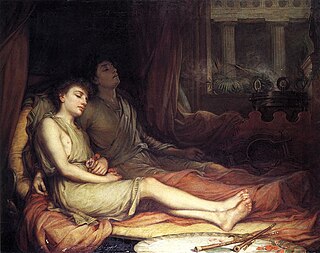
John William Waterhouse was an English painter known for working first in the Academic style and for then embracing the Pre-Raphaelite Brotherhood's style and subject matter. His paintings are known for their depictions of women from both ancient Greek mythology and Arthurian legend. A high proportion depict a single young and beautiful woman in a historical costume and setting, though there are some ventures into Orientalist painting and genre painting, still mostly featuring women.

Benjamin Waterhouse Hawkins was an English sculptor and natural history artist renowned for his work on the life-size models of dinosaurs in the Crystal Palace Park in south London. The models, accurately made using the latest scientific knowledge, created a sensation at the time. Hawkins was also a noted lecturer on zoological topics.

The Art of the United Kingdom refers to all forms of visual art in or associated with the United Kingdom since the formation of the Kingdom of Great Britain in 1707 and encompasses English art, Scottish art, Welsh art and Irish art, and forms part of Western art history. During the 18th century, Britain began to reclaim the leading place England had previously played in European art during the Middle Ages, being especially strong in portraiture and landscape art.

A crystal ball is a crystal or glass ball commonly used in fortune-telling. It is generally associated with the performance of clairvoyance and scrying. Used since Antiquity, crystal balls have had a broad reputation with witchcraft, including modern times with charlatan acts and amusements at circus venues, festivals, etc. Other names for the thing include crystal sphere, scrying ball, shew/show(ing) stone, and more variants by dialect.
A crystal ball is a scrying or fortune telling orb object

An Experiment on a Bird in the Air Pump is a 1768 oil-on-canvas painting by Joseph Wright of Derby, one of a number of candlelit scenes that Wright painted during the 1760s. The painting departed from convention of the time by depicting a scientific subject in the reverential manner formerly reserved for scenes of historical or religious significance. Wright was intimately involved in depicting the Industrial Revolution and the scientific advances of the Enlightenment. While his paintings were recognised as exceptional by his contemporaries, his provincial status and choice of subjects meant the style was never widely imitated. The picture has been owned by the National Gallery in London since 1863 and is regarded as a masterpiece of British art.

Echo and Narcissus is a 1903 oil painting by John William Waterhouse. It illustrates the myth of Echo and Narcissus from Ovid's Metamorphoses.

Boreas is an oil painting in the Pre-Raphaelite style created in 1903 by John William Waterhouse.

Jason and Medea is an oil painting in the Pre-Raphaelite style created by John William Waterhouse in 1907.

The Magic Circle is an 1886 oil painting in the Pre-Raphaelite style by John William Waterhouse. Two copies of the painting were produced. The two paintings and a study depict a witch or sorceress using a wand to draw a fiery magic circle on the Earth to create a ritual space for her ceremonial magic. As was common in the period, Waterhouse repeated his subject on a smaller scale, probably at the request of a collector.

A Philosopher Lecturing on the Orrery, or the full title, A Philosopher giving that Lecture on the Orrery in which a lamp is put in place of the Sun, is a 1766 painting by Joseph Wright of Derby depicting a lecturer giving a demonstration of an orrery – a mechanical model of the solar system – to a small audience. It is now in the Derby Museum and Art Gallery The painting preceded his similar An Experiment on a Bird in the Air Pump.

The Lady of Shalott is a painting of 1888 by the English painter John William Waterhouse. It is a representation of the ending of Alfred, Lord Tennyson's 1832 poem of the same name. Waterhouse painted three versions of this character, in 1888, 1894 and 1915. It is one of his most famous works, which adopted much of the style of the Pre-Raphaelite Brotherhood, though Waterhouse was painting several decades after the Brotherhood split up during his early childhood.

Saint Eulalia is an oil painting on canvas in the Pre-Raphaelite style, created in 1885 by English artist John William Waterhouse, depicting the aftermath of the death of Eulalia of Mérida. It is currently housed at Tate Britain.

The Favourites of the Emperor Honorius is a painting by John William Waterhouse completed in 1883. The painting depicts Honorius feeding birds which are on the rug in front of him; the dark colours of the rug and his clothes define a space. Separated from him and the birds are the councillors seeking his attention, and who along with the attendant are dressed in paler shades.

The Unwelcome Companion: A Street Scene in Cairo is an early painting by John William Waterhouse. Completed in 1873, it was exhibited at the gallery of the Society of British Artists.

I Am Half-Sick of Shadows, Said the Lady of Shalott is a painting by John William Waterhouse completed in 1915. It is the third painting by Waterhouse that depicts a scene from the Tennyson poem, "The Lady of Shalott". The title of the painting is a quotation from the last two lines in the fourth and final verse of the second part of Tennyson's poem:

Sleep and His Half-Brother Death is a painting by John William Waterhouse completed in 1874.

Hylas and the Nymphs is an 1896 oil painting by John William Waterhouse. The painting depicts a moment from the Greek and Roman legend of the tragic youth Hylas, based on accounts by Ovid and other ancient writers, in which the enraptured Hylas is abducted by Naiads while seeking drinking water.

A Reading from Homer is an oil-on-canvas painting executed in 1885 by the English artist Lawrence Alma-Tadema. It depicts an imaginary festival scene from ancient Greece with youth reading poetry to a small audience on a marble balcony overlooking the sea. The painting has been in the collection of the Philadelphia Museum of Art since 1924.



















